Author: Scott KLEINE, Bryan K. LEES & Malcolm SOUTHWOOD Date: 2014-9-7 19:36:07
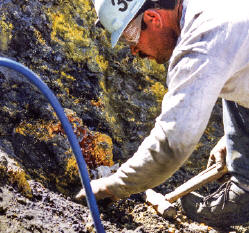
Graham Sutton of Collector’s Edge extracting orpiment pocket in Cut 62. Collector’s Edge photo.
By April 1999, news of the discoveryhad spread and there was growing ex-citement in the mineral community, andfinding a way of preserving as much ofthe specimen quality material as possiblebecame the first priority. Collector’sEdge presented a proposal to Newmont,suggesting how the two companies mightwork together in a manner that allowedmaximum recovery of specimens withminimal disruption to commercial miningoperations. Newmont responded withan excellent plan to identify orpimentzones and to protect them from damageduring blasting operations. A projectmodel was developed, incorporating suggestedcollecting schedules, techniquesand requirements that would allow commercial mining to continue in tandemwith specimen recovery; understandably,it was unthinkable that the mine’soverall production schedule could becurtailed to facilitate the collectingoperation. A collecting contract wascompleted in May, and Collector’s Edgerelocated one of its collecting crews from the Sweet Home mine in Coloradoto Twin Creeks, supervised by GrahamSutton. Meanwhile, Newmont staff,led by Production General ForemanRandy Ford, and Drill and Blast GeneralForeman Lyle Avey, worked out waysto continue gold mining around thecollecting areas without loss of production.
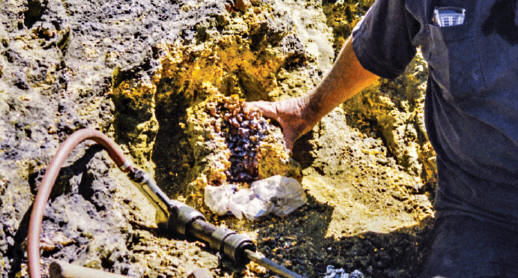
Another pocket almost extracted. Collector’s Edge photo.
Fortunately, the sheer size of theMega pit operation allows for considerableproduction flexibility. Typicallythree of four areas are being mined atany one time, while orpiment recoverywas from a single mining area. Mineplanners were therefore able to adjustproduction strategies in parts of the pitremote from the orpiment recovery projectto ensure that overall gold productionwas maintained.
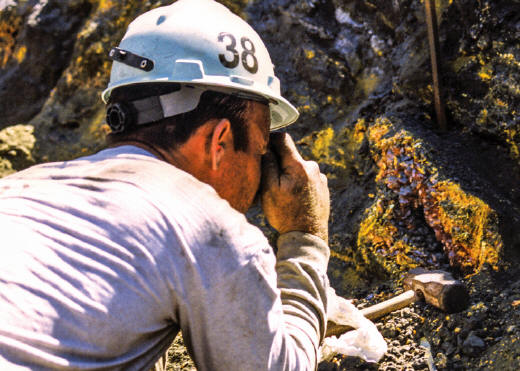
Graham photographing freshly opened pocket in situ, Cut 62. CE photo.
By late May 1999, the Collector’sEdge crew was busy collecting orpimenton the 4200 Bench of Cut 62 and, over theensuing five months, the zone wasworked to a depth of 30 m and thousandsof specimens were recovered. Collectingcrews rotated in and out of the project ona monthly basis, with each crew comprisingthree to four persons “borrowed”from the Sweet Home operation. GrahamSutton remained as the crew leader, withScott Betz and Jon Price rotating as hisassistants. Each crew member was requiredto have mine safety and health administration certification in order tobe allowed site access, and additionalon-site training was provided by Newmontin order to ensure that all specimenrecovery activities were fullycompliant with modern mining codes.
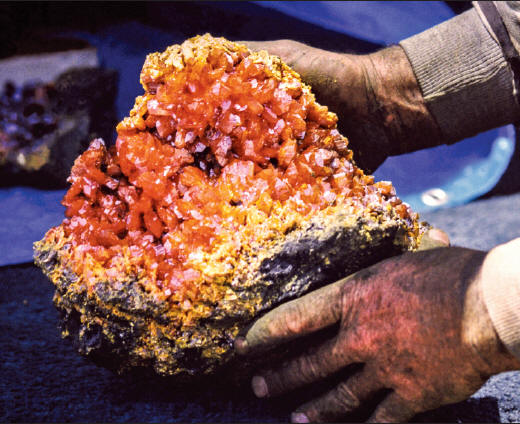
Freshly mined high quality opriment specimen. Collector’s Edge photo.
Between March and September atotal of six collecting campaigns tookplace, each lasting between one and twoweeks. During the first trips the twocompanies – Newmont and Collector’sEdge – devised operating strategies torecover orpiment while minimizing thedisruption to gold mining. The planbegan with logging and mapping the orpimentzones during the drilling stage ofthe blasting schedule; while drilling each blast hole, care was taken to log theareas in which orpiment was observed inthe drill cuttings. Next, all of the holes,except for those that showed orpiment,were shot so that, after the blasted materialwas removed, a long column of orpiment-bearing material was leftstanding in the pit floor.
Typically such acolumn would measure some 30 to 60 min length, perhaps 8 m wide and maybe6m high. This block of material would beentirely removed by the collecting crew,with work slowing right down oncepocket zones were encountered. Pocketswere broken open with air chisels andhand tools, and several excellent specimenswere removed with a diamondchain saw.
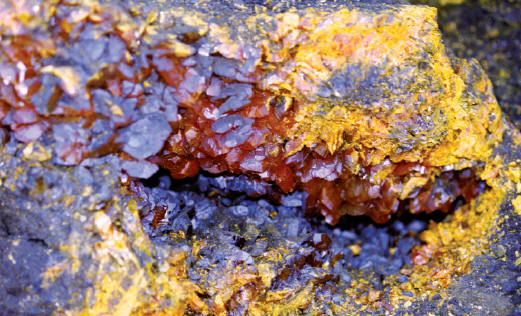
Close-up of the orpiment pocket in situ shown above. G. Sutton photo.
When the block was completelyremoved, the drilling cycle wouldbegin again to drop the floor by another6 m or so.
As the pit was deepened, further orpimentdiscoveries were made. Beginningwith the 4220 bench (which cut thetop of the fold structure), the pit wasdeepened through the 4120 bench so thata 100 feet (c. 30m) thick zone of orpiment-rich ground was removed in 20 foot(c.6m) intervals. Below the 4120 bench, the fold structure pinched out and no furtherspecimen quality pockets werefound in Cut 62. All in all, the Cut 62 orpimentzone comprised a block of groundsome 30 m thick, 7 m wide, and 90 mlong, constituting a rock volume of some19,000 cubic meters.
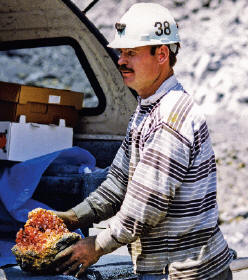
Graham with freshly mined high quality opriment specimen, see close-up at left. Collector’s Edge photo.








 YueGongAnBei 44051102000467
YueGongAnBei 44051102000467


 |
|